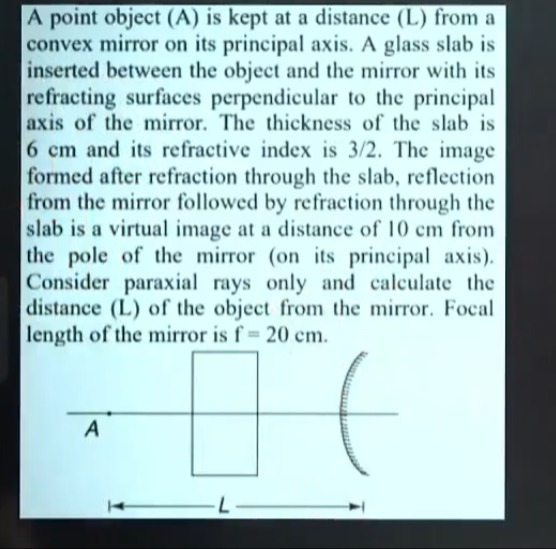Question
Question: A point object (A) is kept at a distance (L) from a convex mirror on its principal axis. A glass sla...
A point object (A) is kept at a distance (L) from a convex mirror on its principal axis. A glass slab is inserted between the object and the mirror with its refracting surfaces perpendicular to the principal axis of the mirror. The thickness of the slab is 6 cm and its refractive index is 3/2. The image formed after refraction through the slab, reflection from the mirror followed by refraction through the slab is a virtual image at a distance of 10 cm from the pole of the mirror (on its principal axis). Consider paraxial rays only and calculate the distance (L) of the object from the mirror. Focal length of the mirror is f = 20 cm.

32 cm
Solution
The problem involves refraction through a glass slab and reflection from a convex mirror.
-
Refraction through the slab: When light from an object in air passes through a glass slab of thickness t and refractive index μ, the apparent position of the object as seen from the other side in air is shifted by a distance s=t(1−1/μ) towards the slab. In this case, s=6(1−1/(3/2))=6(1−2/3)=6(1/3)=2 cm.
-
Effective object distance for the mirror: The effective object distance for the mirror is Leff=L−s=L−2.
-
Mirror formula: Using the mirror formula, 1/v1+1/u1=1/f, where u1=−(L−2) and f=20 cm.
1/v1+1/(−(L−2))=1/20
1/v1=1/20+1/(L−2)=(L−2+20)/(20(L−2))=(L+18)/(20(L−2))
v1=20(L−2)/(L+18)
-
Second pass through the slab: The light rays are reflected from the mirror and travel back towards the slab. The slab is placed between the mirror and the final image. The final image is virtual and at a distance of 10 cm from the pole of the mirror.
The effective position of the image I1 after passing through the slab is shifted by t(1−1/μ)=2 cm away from the slab. Since the final image is at 10 cm from the mirror, the effective position of the image I1 as seen from the left of the slab is at a distance 10+2=12 cm from the mirror. So v1=12.
-
Solving for L: 12=20(L−2)/(L+18)
12(L+18)=20(L−2)
3(L+18)=5(L−2)
3L+54=5L−10
2L=64
L=32 cm
Therefore, the distance (L) of the object from the mirror is 32 cm.
